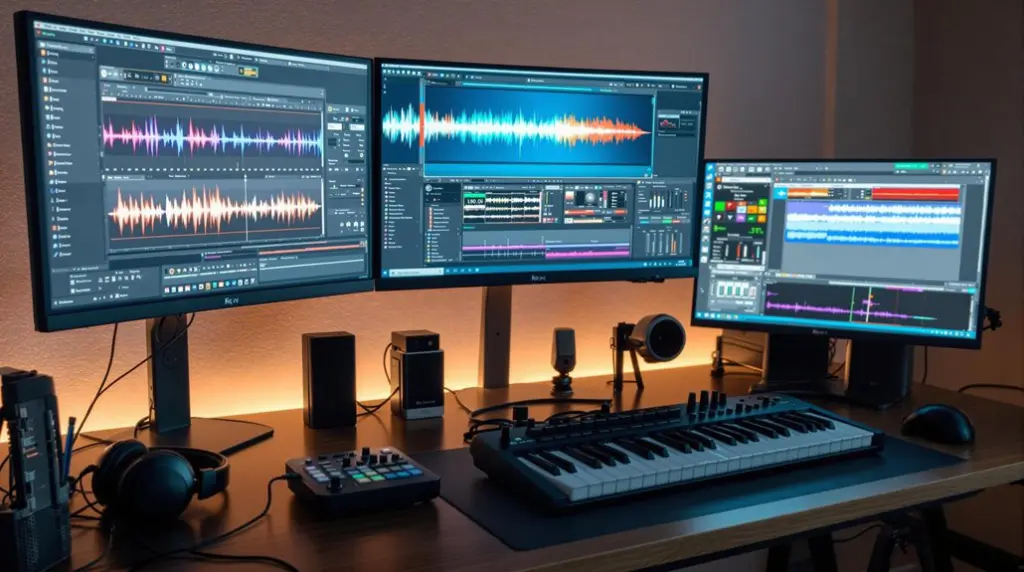The Antares Harmony Engine VST Plugin excels in delivering real-time vocal harmony adjustments, offering four independent harmony voices with advanced pitch detection and throat-modeling technology for seamless integration with lead vocals. MIDI control and note-by-note generation modes provide intricate manipulation, though high CPU usage and initial setup complexity present challenges. While sound quality receives mixed reviews, requiring careful parameterization to avoid phasy or artificial output, the plugin’s creative potential for intricate vocal arrangements is notable. The competitive pricing and extensive features make it a compelling tool despite certain limitations, appealing to those who seek to explore its full capabilities.
Key Takeaways
- Generates four independent harmony voices with real-time pitch correction and throat modeling for natural sound.
- MIDI control integration enables intricate manipulation and fine-tuning of harmony voices.
- High CPU usage may compromise live performance; optimization is necessary.
- Installation is complex and requires careful attention to hidden files and detailed instructions.
- Mixed reviews on sound quality; manual adjustments are often needed to achieve professional-grade harmonies.
Overview of Antares Harmony Engine
When delving into the capabilities of the Antares Harmony Engine, it becomes immediately apparent that this vocal harmonizer plugin is engineered to markedly enhance vocal performances across a spectrum of music genres. The plugin’s advanced vocal manipulation technology allows for the creation of four independent harmony voices, providing a robust platform for intricate harmony styles.
Users can generate harmonies either note by note or through an automatic generation mode, offering a versatile approach to vocal dynamics. This dual methodology enables detailed customization, ensuring that each harmony layer can be meticulously tailored to the lead vocal or monophonic instrument input. The incorporation of real-time editing features facilitates instant tweaks during playback, optimizing the workflow for producers.
Antares Harmony Engine further incorporates real-time pitch correction and throat modeling technology, which considerably improves the realism and quality of the generated harmonies. The inclusion of these features allows for seamless integration with the original vocal track, preserving its natural timbre while adding rich harmonic textures.
The plugin’s MIDI integration facilitates precise real-time manipulation of harmony settings during both live performances and studio recordings, making it a valuable tool for musicians, producers, and audio engineers. Its widespread use in genres such as pop, R&B, and electronic music underscores its versatility and effectiveness in enhancing vocal tracks.
Key Features and Performance
The Antares Harmony Engine VST Plugin excels in real-time vocal adjustment, offering seamless integration of four-part harmony creation with precise pitch control.
Its MIDI control capabilities enable intricate manipulation of harmony voices, providing unparalleled flexibility for complex vocal arrangements.
Additionally, features such as the Formant Knob allow for creative vocal sound manipulation, enhancing the overall performance of the plugin.
However, the high CPU usage could pose challenges for live performance scenarios, necessitating careful optimization to mitigate latency issues.
For those looking to explore more, experiment with different vocal styles and genres using the Harmony Engine can lead to discovering unique sound possibilities.
Real-time Vocal Adjustment
Enhancing vocal performances in real-time, the Antares Harmony Engine VST Plugin stands out with its capability to generate four independent harmony voices, offering an unparalleled degree of customization in vocal arrangements. This tool is particularly advantageous for live performances, where vocal creativity and precision are essential.
The plugin’s advanced vocal manipulation technology guarantees faster and more accurate pitch detection, seamlessly integrating harmonies with lead vocals.
Key features include:
- Throat-Modeling Technology: This feature improves vocal processing, providing a natural sound to generated harmonies, vital for achieving a polished live performance.
- MIDI Control: Users can employ MIDI control for precise adjustments to harmony settings, enabling real-time manipulation during recordings or live sets, thereby greatly improving vocal creativity.
- Pitch Detection: The plugin’s rapid and precise pitch detection technology guarantees harmonies blend smoothly with the lead vocals, minimizing the risk of dissonance.
- Ease of Use: The intuitive interface allows users to produce smooth, rich harmonies with minimal effort, making it effective even in demanding genres like electronic music.
These features collectively make the Antares Harmony Engine VST Plugin an indispensable tool for musicians seeking to enhance their vocal arrangements in real-time contexts.
Four-part Harmony Creation
Creating intricate vocal arrangements becomes a sophisticated endeavor with the Antares Harmony Engine’s capability to generate four independent harmony voices. This feature considerably enhances the richness and depth of the primary vocal track, leveraging advanced vocal manipulation technology to deliver smooth and realistic harmonies.
The engine employs throat-modeling and real-time pitch correction, critical in refining vocal layering techniques and ensuring harmonies blend seamlessly with the original voice.
Users benefit from 15 presets and multiple harmony control modes, offering flexibility in harmony creation. Whether opting for automatic generation or note-by-note customization, the plugin adapts to various production needs. This versatility is vital for producers aiming to tailor harmonies to specific genres, particularly in pop and electronic music where precision in vocal layering is paramount.
However, despite its robust capabilities, some users report challenges with the realism of generated harmonies. Achieving ideal results often necessitates careful manual adjustments using harmony tuning methods.
This fine-tuning process, although time-consuming, is essential for attaining professional-grade harmonies that meet the high standards of contemporary music production.
MIDI Control Integration
Leveraging MIDI control integration, Antares Harmony Engine greatly expands the possibilities for real-time harmony creation and performance. This advanced feature allows users to input MIDI chords that generate harmonies instantaneously, providing a seamless extension to traditional MIDI workflows.
The plugin’s ability to handle four separate MIDI parts for independent harmony lines guarantees unparalleled flexibility in crafting intricate vocal arrangements.
Key Features:
- Real-time MIDI Harmony Generation: Users can input MIDI chords to produce harmonies in real-time, facilitating a fluid and dynamic approach to harmony customization.
- Four-Part MIDI Control: By allowing four distinct MIDI parts to trigger separate harmony lines, composers can achieve a level of complexity and nuance that is often desired in professional settings.
- MIDI Omni Mode: This mode enhances performance capabilities by providing immediate, real-time control over harmony adjustments, making it an invaluable tool for live performances.
- Fine-Tune Harmony Parameters: MIDI control allows precise customization of harmony parameters, enabling users to tailor vocal arrangements with high accuracy.
Despite the noted latency issues, the plugin’s robust MIDI control integration greatly enhances its utility, particularly in live settings where dynamic performance variations are vital.
This feature positions the Antares Harmony Engine as a versatile tool for musicians seeking sophisticated harmony creation.
User Experiences and Feedback
User feedback on the Antares Harmony Engine VST Plugin highlights a dichotomy in ease of use and sound quality.
While some users commend the plugin’s intuitive interface and seamless real-time vocal tracking, others report significant navigational challenges and font size issues that hinder usability.
Additionally, the sound quality receives mixed reviews, with commendations for its performance on single female harmonies contrasted by criticisms of a “phasy, warbly, clouded sound” on pre-recorded tracks.
Ease of Use
Maneuvering the Antares Harmony Engine VST Plugin presents a mixed bag of user experiences, with some musicians and producers praising its intuitive layout, while others report significant challenges primarily related to the user interface and font size.
These mixed reviews highlight several aspects of the plugin’s ease of use, which can vary widely depending on the user’s background and expectations.
- User Interface: The layout is generally appreciated for its logical organization, yet the small font size can be problematic for users working on high-resolution screens. This issue detracts from the overall ease of navigation and usability.
- Learning Curve: The plugin’s complex design, particularly the numerous per-channel parameters, contributes to a steeper learning curve. New users often find themselves investing substantial time to master its full capabilities.
- Installation Process: The setup requires careful attention to detail to avoid confusion, especially concerning hidden files. Specific instructions must be followed to guarantee a smooth installation, which can be a barrier for less tech-savvy users.
- Pre-Purchase Testing: The absence of a demo version has led to frustrations, as users cannot test the plugin’s functionality before committing to a purchase. This has resulted in misleading product information and unmet expectations for some customers.
Sound Quality
While steering through the user interface and mastering the intricacies of the installation process can present challenges, the sound quality of the Antares Harmony Engine VST Plugin remains a significant area of focus for many users.
Regarding sound design, feedback is decidedly mixed. Some users describe the plugin’s harmonies as “phasy, warbly, clouded,” pointing to a lack of clarity and cohesion in the vocal processing. These descriptions suggest a need for careful parameterization to avoid an artificial sound.
Conversely, others appreciate the dual harmony feature and octave manipulation, noting that the plugin can produce “magical results” in live vocal tracking scenarios. This indicates that, with proper adjustments, the Harmony Engine can excel in real-time applications.
However, when compared to competitors like Celemony and Melodyne, critics argue that the Antares Harmony Engine often falls short in delivering natural-sounding output. This comparative insight is significant for users prioritizing authenticity in their vocal processing.
Additionally, the presets have been found inadequate by some, necessitating manual tweaks to achieve desirable results. While the potential for realistic harmonies exists, the plugin demands a meticulous approach to sound design, highlighting both its strengths and limitations.
Pricing and Value
In the domain of digital audio workstations, the pricing and value of the Antares Harmony Engine VST Plugin present a nuanced discussion. Given the current market trends, the plugin’s discounted price of $149.00—down from $200.00—offers a considerable 48% savings, making it more accessible for budget-conscious users.
However, a competitive analysis reveals that its value proposition is mixed, especially when factoring in the additional $100 cost for an iLok, raising the total investment to $250. This price point may be justified if the plugin includes essential mastering tools like EQ and compression or advanced audio processing techniques.
Key Considerations:
- Discounted Price: The plugin is now available for $149.00, a reduction that makes it more affordable but still leaves room for debate about its value.
- Financing Options: Users can opt for special financing, which allows payments as low as $4.23 per month for 36 months, making the investment more manageable.
- Total Investment: The additional iLok cost brings the total to $250, which some users find steep considering the perceived performance of the plugin.
- User Perception: While some first-time users find it affordable, others describe it as a low-value toy rather than a professional tool, highlighting its polarizing reception in the market.
This analysis suggests that while the Antares Harmony Engine is competitively priced, its perceived value varies greatly among users.
Installation and Setup
Evaluating the pricing and value of the Antares Harmony Engine naturally leads us to contemplate the practical aspects of its installation and setup. The installation process necessitates meticulous attention to detail, particularly regarding file options and hidden files, which can complicate the initial setup. Users are urged to adhere strictly to the provided instructions to avoid potential confusion and to guarantee a smooth installation.
A significant setup challenge noted by users is the plugin’s compatibility constraints, limited to DAWs supporting VST3, AAX, or AU formats. Prior verification of your DAW’s compatibility is recommended to preempt any installation issues.
Additionally, the plugin’s user interface has been cited as problematic, with some users reporting difficulties related to font size, which can hinder usability during setup.
Absence of a demo version poses another challenge, leaving potential users without a means to evaluate the software’s functionality prior to purchase. This uncertainty can make the installation a more intimidating task, as users are unable to trial the software beforehand.
Compatibility and Support
Compatibility and Support
Compatibility and support for the Antares Harmony Engine are essential factors that directly impact its usability and integration within various digital audio workstations (DAWs). The plugin is designed to be compatible with major DAWs, supporting vital formats such as VST3, AAX, and AU. However, several aspects require closer scrutiny to understand potential plugin limitations that could lead to user frustration. DJs and producers should also be aware of the importance of obtaining proper licenses when using plugins and tracks to guarantee legal compliance.
- DAW Compatibility: The Harmony Engine works seamlessly with industry-standard DAWs hosting VST3, AAX, and AU formats. Yet, users must verify their DAW versions align with the plugin’s requirements to avoid compatibility issues.
- Technical Support: Personalized product advice is accessible through Sales Engineers via email or phone at 800-222-4700. This support system guarantees users can resolve technical difficulties swiftly, enhancing user experience.
- Latency Concerns: Not optimized for live audio tracking, the plugin necessitates a buffer size of 512 or 1024 samples. This setting can introduce latency, impacting its utility in live performance scenarios and potentially leading to user frustration.
- Marketing Transparency: There is a notable lack of clear marketing regarding the plugin’s limitations for live performance. This oversight can mislead potential users, causing dissatisfaction when latency issues arise during live settings.
Understanding these factors is essential for users to make informed decisions and optimize their workflow effectively.
Pros and Cons
When evaluating the practical applications of the Antares Harmony Engine, it becomes evident that the plugin offers a mix of robust features and remarkable drawbacks. One of the most compelling aspects is its capability for harmony manipulation techniques, facilitated by four independent harmony voices. This flexibility allows for intricate and customizable vocal arrangements that can considerably enhance a track’s depth and complexity.
In addition, its MIDI integration is a remarkable advantage, enabling real-time control of harmony generation, which is particularly beneficial for live performances and dynamic studio work. However, users should also consider employing a parametric EQ for precise adjustments, as this can help mitigate some of the sound quality issues.
However, the sound quality of these harmonies is a point of contention. Users have reported instances where the harmonies sound artificial or exhibit a “phasy” quality, undermining the overall professionalism of the output. This issue may deter those seeking high-fidelity vocal layering strategies.
Moreover, the initial installation process can be cumbersome due to hidden files and specific setup instructions, leading to user frustration.
While the plugin is praised for its creative potential, some professionals view it as a “low-value toy” rather than a high-grade tool, especially when considering its pricing and performance limitations. Consequently, while the Harmony Engine offers substantial creative tools, its drawbacks cannot be overlooked.
Frequently Asked Questions
Is Antares Harmony Engine Worth It?
Antares Harmony Engine, while offering advanced vocal layering, pitch shifting, and harmony blending capabilities, presents mixed value. Though it excels in creating creative effects, its high cost, CPU-heavy usage, and installation complexities may deter some potential users.
What Is the Best Harmonizer Plugin for Vst?
For ideal vocal layering and sound design, Celemony Melodyne stands out among harmonizer plugins. Its advanced pitch correction and creative harmonies offer superior results. A detailed plugin comparison consistently highlights Melodyne’s effectiveness in professional audio production environments.
What Is Autotune Harmony Engine?
The Auto-Tune Harmony Engine is a sophisticated vocal processing VST plugin that generates harmonies using advanced pitch detection and correction technology, allowing for precise real-time adjustments and flexibility. It supports detailed parameter control for professional results.
How to Use Antares Harmony Engine With Midi?
To use Antares Harmony Engine with MIDI, guarantee accurate MIDI configuration and adjust harmony settings meticulously. This enables precise control over harmony generation, allowing for real-time manipulation of harmony lines and enhanced live performance capabilities.
Conclusion
To sum up, the Antares Harmony Engine VST plugin stands out as a robust tool for creating intricate vocal harmonies. Its key features, including real-time harmony generation and advanced pitch correction, cater to both novice and professional users. The plugin’s performance is enhanced by user-friendly interfaces and extensive support. While the pricing may be deemed high by some, the value provided justifies the investment. Compatibility across various digital audio workstations further solidifies its position in the market.




